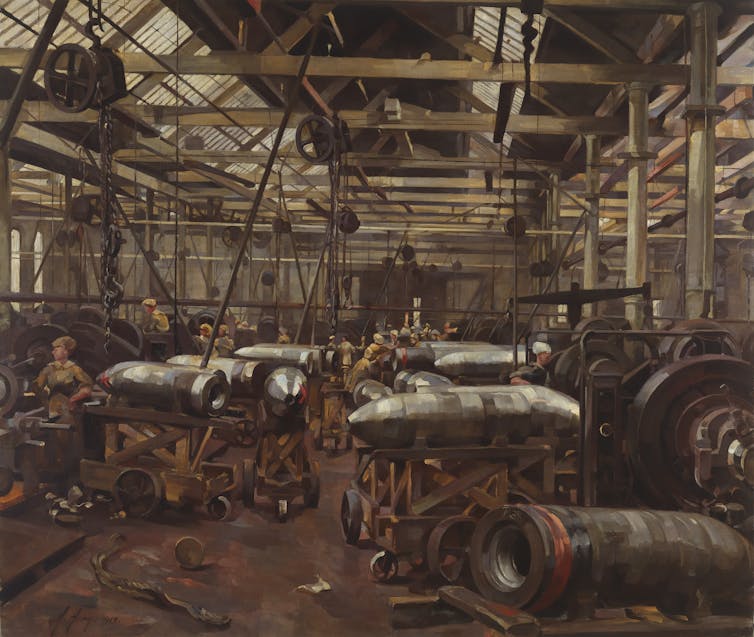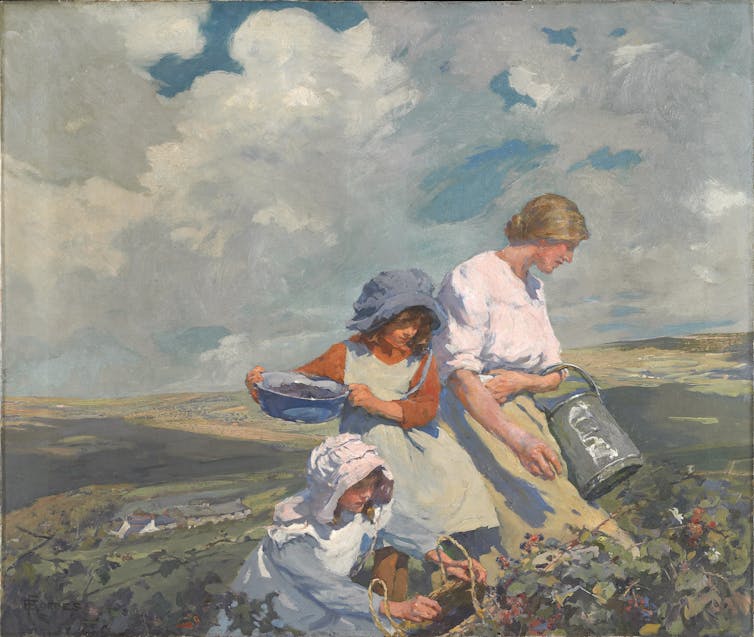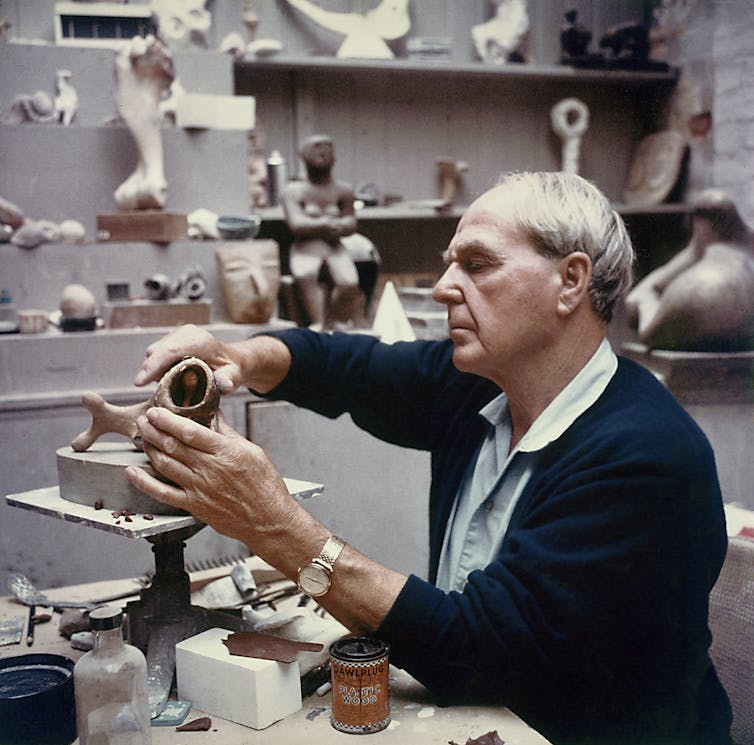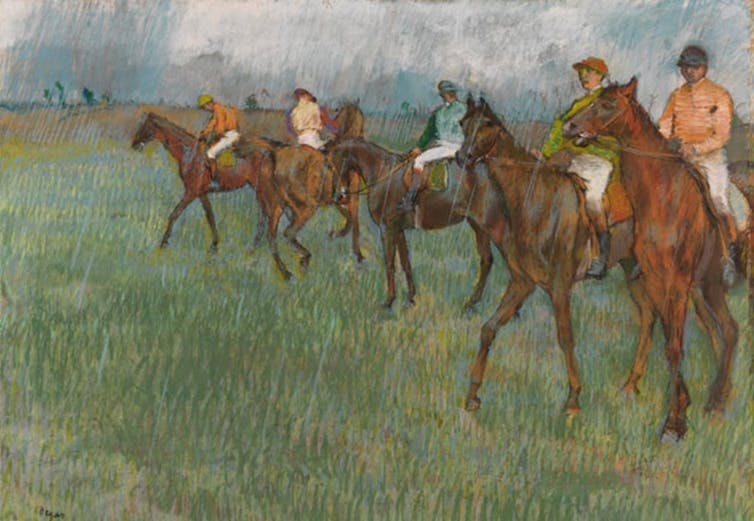This article was first published in our email newsletter Something Good, which every fortnight brings you a summary of the best things to watch, visit and read, as recommended and analysed by academic experts. Click here to receive the newsletter direct to your inbox.
You might not know this, but the team at The Conversation is spread out across the UK and that includes the arts team. We curate your cultural content from Yorkshire, London and the rural environs of Glasgow.
This week, however, we came together to catch up, celebrate our wins and see Something Good together. As we looked at what was on in England’s capital we were excited to see that the art world is gearing up for summer with many blockbuster shows opening. So we decided to dedicate this newsletter to the shows our academic experts are most excited about.
We have to start with the exhibition we visited together, even though it was decidedly NSFW (not safe for work) – Beryl Cook/Tom of Finland at Studio Voltaire in London.
Radical, fleshy and full of frolics, the images created by Cook and Finland are a joy but also not for the fainthearted. When our editor Jane was looking for pictures to accompany our brilliant review, she struggled to find many which were on the less risqué side. Finland’s illustrations are of men, all bulging muscles dripping in sex and leather; while Cook’s paintings are often of larger-than-life women raucously indulging in similarly hedonistic pursuits.
Both artists revel in exaggerated bodies which have, for one reason or another, been criticised or condemned. Their art also wasn’t taken seriously enough at one time or another. Shown together, they make fitting bedfellows. As our reviewer, an expert in fine art says: “Finland lends Beryl a serious, alternative and queer cultural context, while Cook brings out the essential joy and wry humour in Tom’s work.”
Read more: Beryl Cook and Tom of Finland exhibition: how an odd pairing bring out the best in each other
Including women artists and reimagining landscapes
Another show in London attempting to right legacies and place artists back in the public eye is the Tate’s Now You See Us: Women Artists in Britain 1520–1920. There has been a trend in recent years to address the lack of women in gallery collections and on show in exhibitions. This might be one of the most comprehensive shows of its kind, and is the culmination of years of research in the Tate’s archives to recover lost works and histories of women artists.

While there are artists in the show you will have heard of, like Artemisia Gentileschi, the curators have made sure it’s mostly full of those you’ve likely not. Our reviewer felt that “the exhibition is persuasive in its argument [and] stunning in its scope”. Highlights for her included the work of the UK’s first official female war artist, Anna Airy (1882–1964). On display are a handful of her depictions of moody munitions factories with shades of red and brushstrokes so alive you can imagine the heat of the furnaces just looking at them.
In Liverpool, another show trying to showcase the women artists in their collection is Another View: Landscapes by Women Artistsat Lady Lever Art Gallery. Instead of just focusing on women, the curators have decided to do so through the lens of landscape art.

In the last few decades landscape seems to have become a byword for environment. This show, however, takes its actual meaning, which is the shaping of land as a cultural activity. The curation asks myriad questions, from how did the traditional idea of the English landscape get popularised to who has been excluded from these depictions?
You will see paintings of manicured vistas where the toil of peasants and slaves is evident but in which they are invisible. You will also see paintings and photographs where they have finally been drawn back in, their work vital and centre to the landscape artwork. While it can’t rewrite the past it gives space, as our reviewer notes, to imagine what was lost and what could and should be.
Ugly no more
The distinctive undulating curves and solid heft of Henry Moore’s sculptures can be seen all over the world – often in public spaces. This is because they are monumental and moving, able to fill and give character to large open areas. However, many of these works didn’t start that way. Often they began in forms that could fit in the palm of most people’s hands.

These wonderful miniatures are on show for the very first time at the Holburne Museum in Bath. In this exhibition you can get up close with Moore’s process, seeing the skill and evolution behind some of his most popular public works. You can, as our reviewer notes, also understand the feelings and politics of the post-second world war period, which inspired these moving works that beautifully capture the human condition.
Read more: Henry Moore in Miniature shows the brutal influence of wartime on the sculptor's work
When Moore first showed his work, one early reviewer said it expressed “the cult of ugliness”. Another artist you might be surprised was subject to similar criticism, albeit at a different time and for different reasons, was Edgar Degas.
Considered a master now, when Degas’ work first showed in the UK some of it was criticised for its “distressing ugliness”. One man who paid no heed to this and who showed some taste and foresight was the Glasgow shipbuilder and art collector Sir William Burrell, who purchased 22 of the French impressionist’s works.

To mark the 150th anniversary of the first impressionist exhibition, these will be on show at Glasgow’s Burell Collection along with 28 others in Discovering Degas, which celebrates the changing taste for his work in Britain. As our reviewer writes, this exhibition shows not only “the innovative and experimental nature of the artist’s work, but the foresight and boldness of these early collectors, including Burrell”.

